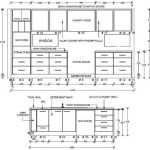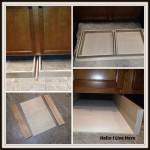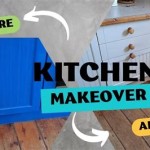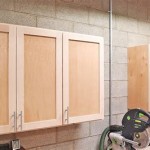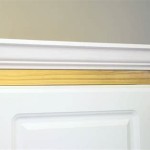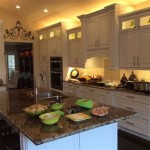How to Make Your Own Kitchen Cabinet Knobs
Replacing kitchen cabinet hardware represents a straightforward and budget-friendly method to update a kitchen's aesthetic. Rather than purchasing new knobs from retail stores, creating personalized knobs offers a unique opportunity to inject individual style and potentially reduce costs. This article provides a detailed guide on how to fabricate custom kitchen cabinet knobs using various materials and techniques.
Selecting Materials and Tools
The first step in crafting custom cabinet knobs involves selecting appropriate materials. The material choice will significantly impact the final appearance, durability, and method of construction. Common materials include wood, resin, metal, ceramic clay, and even repurposed items. Each material presents distinct advantages and disadvantages.
Wood: Wood offers versatility and aesthetic appeal. Hardwoods like oak, maple, and walnut provide durability and a refined look. Softwoods, such as pine, are more affordable but require careful sealing and finishing to prevent damage. Wood can be shaped using woodworking tools like saws, drills, sanders, and lathes. The versatility of wood allows for various designs, from simple geometric shapes to intricate carvings.
Resin: Resin, particularly epoxy resin, enables the creation of translucent or colorful knobs. It can be combined with pigments, dyes, and embedded objects (such as shells, beads, or dried flowers) to create unique visual effects. Resin requires molds, measuring cups, mixing sticks, and safety equipment like gloves and respirators to prevent exposure to fumes. The curing process can take several hours or days, depending on the resin type and ambient temperature.
Metal: Metal knobs, crafted from materials like brass, copper, aluminum, or steel, offer a contemporary and durable option. Fabricating metal knobs necessitates specialized tools such as a metal lathe, cutting tools, welding equipment (if joining multiple pieces), and polishing tools. Working with metal requires safety precautions, including wearing eye protection and gloves, due to the potential for sharp edges and heat.
Ceramic Clay: Ceramic clay provides a tactile and artistic option for creating knobs. It allows for shaping by hand or using a potter's wheel. After shaping, the clay must be fired in a kiln to harden and become durable. Glazes can then be applied to add color and a protective finish. Ceramic clay requires access to a kiln, various shaping tools, and glazing materials.
Repurposed Items: Repurposing existing items presents an environmentally conscious and creative approach. Buttons, drawer pulls from antique furniture, stones, or even small pieces of hardware can be adapted into unique cabinet knobs. This approach requires careful selection of items that are structurally sound and aesthetically appealing. Adhesives, drill bits, and mounting hardware are necessary to attach the repurposed item to the cabinet door.
Beyond the raw materials, various tools are essential for the fabrication process. These commonly include:
- Drill: Used to create pilot holes for mounting screws.
- Screwdriver: Necessary for attaching the knobs to the cabinet doors.
- Measuring Tools (Ruler, Caliper): Ensure consistent dimensions and accurate placement of mounting holes.
- Sandpaper: Used for smoothing surfaces and preparing them for finishing.
- Clamps: Secure materials during shaping or gluing.
- Adhesives: Epoxy, wood glue, or metal adhesives are used to bond different components.
- Finishes: Paint, varnish, lacquer, or sealant protects the material and enhances the appearance.
Specific tools will vary depending on the chosen material. For example, working with wood requires saws, chisels, and possibly a lathe, while working with resin necessitates molds and mixing equipment.
Crafting Techniques for Different Materials
The process of creating cabinet knobs differs significantly depending on the selected material. Below are detailed instructions for working with several common materials:
Wood Knobs:
- Design and Cut: Sketch the desired knob shape and dimensions. Cut the wood blank to the approximate size using a saw.
- Shaping: Shape the wood using chisels, files, or a lathe. If using a lathe, secure the wood blank and gradually shape it to the desired profile. For simpler shapes, hand tools can be used.
- Sanding: Sand the knob progressively with finer grits of sandpaper to achieve a smooth surface. Start with a coarser grit (e.g., 120) and move to finer grits (e.g., 220 and 320).
- Drilling: Drill a pilot hole in the center of the knob for the mounting screw. Ensure the hole is deep enough and straight.
- Finishing: Apply a finish such as paint, stain, varnish, or lacquer. Allow the finish to dry completely between coats. Multiple coats may be necessary for durability and desired appearance.
Resin Knobs:
- Mold Preparation: Select or create a mold for the desired knob shape. Silicone molds are readily available and easy to use. Alternatively, molds can be made from plastic containers or other flexible materials.
- Resin Mixing: Carefully measure and mix the resin and hardener according to the manufacturer's instructions. Add pigments, dyes, or embedded objects at this stage. Thoroughly mix the resin to ensure even distribution of color and additives.
- Pouring: Pour the resin mixture into the mold. Gently tap the mold to release any trapped air bubbles.
- Curing: Allow the resin to cure completely according to the manufacturer's instructions. This usually takes several hours or days.
- Demolding: Once the resin is cured, carefully remove the knob from the mold.
- Finishing: Sand any rough edges or imperfections. Drill a pilot hole for the mounting screw. Consider applying a clear coat or varnish for added protection and gloss.
Metal Knobs:
- Cutting and Shaping: Cut the metal to the desired size and shape. This may involve using a metal saw, cutting torch, or plasma cutter. Shape the metal using a hammer and anvil or a metal lathe.
- Joining (if necessary): If the knob consists of multiple pieces, join them using welding, soldering, or brazing. Ensure the joints are strong and smooth.
- Finishing: Grind and polish the metal to remove any sharp edges or imperfections. Use a metal polish to achieve a desired shine.
- Drilling: Drill a pilot hole for the mounting screw. If necessary, tap the hole to create threads for the screw.
- Sealing (optional): Apply a clear coat or sealant to prevent tarnishing or corrosion, especially with metals like brass or copper.
Ceramic Clay Knobs:
- Shaping: Shape the clay by hand or using a potter's wheel. Experiment with different shapes and textures.
- Drying: Allow the clay to dry slowly and evenly to prevent cracking.
- Firing: Fire the clay in a kiln according to the clay manufacturer's instructions. This vitrifies the clay, making it hard and durable.
- Glazing: Apply a glaze to the fired clay. Glazes can add color, texture, and a protective finish.
- Second Firing: Fire the glazed piece in the kiln to melt the glaze and fuse it to the clay body.
- Drilling: After the second firing, drill a pilot hole for the mounting screw. Use a diamond-tipped drill bit to prevent chipping or cracking.
Repurposed Items:
- Selection and Preparation: Choose an appropriate repurposed item that is structurally sound and aesthetically pleasing. Clean the item thoroughly to remove any dirt or debris.
- Attachment Method: Determine the best method for attaching the repurposed item to the cabinet door. This may involve drilling a hole and using a screw, gluing the item to a mounting plate, or using a combination of both.
- Adhesive Application (if applicable): Apply a strong adhesive, such as epoxy, to the back of the repurposed item or to the mounting plate.
- Secure Attachment: Secure the item to the cabinet door using the chosen attachment method. Use clamps to hold the item in place while the adhesive dries.
- Finishing (optional): Apply a sealant or clear coat to protect the repurposed item and enhance its appearance.
Mounting the New Knobs
After crafting the knobs, the final step involves mounting them onto the kitchen cabinets. Proper alignment and secure attachment are crucial for functionality and aesthetics.
Preparation: Remove the existing knobs and clean the cabinet doors. Measure the distance between the screw holes on the old knobs (if applicable). This measurement will help determine the placement of the new knobs if utilizing existing holes.
Marking: Mark the location for the new knobs on the cabinet doors. Use a ruler and level to ensure accurate and consistent placement. A template can also be used to ensure uniform placement across all cabinets.
Drilling (if necessary): If new holes are required, drill pilot holes at the marked locations. Choose a drill bit that is slightly smaller than the diameter of the mounting screws.
Attachment: Insert the mounting screws through the cabinet door and into the knobs. Tighten the screws securely, but avoid over-tightening, which can damage the cabinet door or strip the threads in the knob.
Adjustment: After attaching the knobs, check their alignment and function. Adjust as necessary to ensure they are straight and operate smoothly. Consider adding washers between the knob and cabinet door if needed to achieve proper spacing or prevent damage to the cabinet finish. Repeat the process for all remaining cabinet doors.

How To Install Cabinet Knobs And Create Your Own Installation Template A Pinch Of Joy

Simple Homemade Jig For Cabinet Door Pulls

Home Dzine Craft Ideas Crafty Ways To Make Your Own Handles And Knobs

How To Create A Custom Looking Kitchen Mixing Hardware Styles

How To Create A Custom Looking Kitchen Mixing Hardware Styles

Home Dzine Craft Ideas Crafty Ways To Make Your Own Handles And Knobs

15 Simply Genius Drawer Pulls To Dress Up A Dresser Diy Gemstone Cabinet Doors Repurposed

10 Simple Ideas To Update Your Kitchen Cabinets Jenna Sue Design

Kitchen Design Ideas Hardware Is Jewelry For Your Cabinets

Our Favorite Cabinet Hardware Christopher Scott Cabinetry
Related Posts


